How Figurative Oil Painting Changes Conventional Artistic Expression
How Figurative Oil Painting Changes Conventional Artistic Expression
Blog Article
Grasping the Art of Figurative Oil Painting: Essential Tips and Techniques for Aspiring Artists
Figurative oil paint represents an intricate intersection of method and analysis, demanding a complete comprehension of human composition, make-up, and color theory. An expedition of shade harmony and structure strategies can considerably improve the aesthetic impact of their work.

Recognizing Human Anatomy
Comprehending human composition is essential for any kind of musician aiming to understand metaphorical oil paint. A comprehensive grasp of the human form enables artists to create lifelike representations that resonate with viewers. Knowledge of anatomical structures, such as muscles, joints, and bones, gives essential understanding right into just how the body steps and positions.
Musicians need to acquaint themselves with the percentages of the human figure, including the partnership in between various body parts and how these percentages differ across genders and ages. This recognition permits accurate scaling and viewpoint in their job. Furthermore, understanding the underlying musculature boosts the capacity to illustrate movement and tension in a figure, resulting in a much more vibrant and engaging composition.
Examining anatomy also helps in identifying refined nuances in posture and expression, which are critical for sharing emotion and story within a painting. Resources such as physiological textbooks, life illustration sessions, and on the internet tutorials can be indispensable tools for musicians seeking to strengthen their anatomical expertise. Ultimately, understanding human composition not only boosts technical ability but additionally enriches a musician's creative vision, allowing them to bring their figurative oil paintings to life with credibility and depth.
Value of Composition

Trick concepts of structure include balance, unity, and centerpieces. Attaining equilibrium makes certain that no single aspect overwhelms the others, while unity develops a sense of harmony throughout the item. Focal factors accentuate substantial facets of the art work, permitting viewers to engage with the narrative or motif more deeply.
Additionally, making use of leading lines and the guideline of thirds can considerably enhance structure. Leading lines naturally assist the customer's look via the painting, while the regulation of thirds gives a structure for putting crucial elements in an aesthetically attractive manner. By mastering make-up, aiming artists can elevate their metaphorical oil paints, transforming them into engaging visual stories that reverberate with their audience.
Mastering Shade Theory
Shade concept functions as a fundamental facet of figurative oil painting that enhances the principles of make-up. Recognizing the color wheel, that includes main, secondary, and tertiary shades, is necessary for producing unified combinations and effective aesthetic narratives.
Trick ideas such as useful link saturation, tone, and worth play a critical function in identifying the state of mind and impact of a paint. Artists must explore great and warm shades to stimulate particular feelings; warm colors often communicate power and passion, while great colors can convey calmness and tranquility.
The connection in between corresponding shades-- those contrary each various other on the more information shade wheel-- can develop striking contrasts and vibrant structures. When compared, these colors enhance each other's vibrancy, attracting the viewer's eye and including deepness to the artwork.
Furthermore, understanding comparable shades allows artists to accomplish a feeling of unity and coherence. By choosing colors that are surrounding on the wheel, one can preserve a well balanced atmosphere throughout the item.
Eventually, mastering color concept gears up aspiring artists with the devices needed to manipulate shade intentionally, enhancing their ability to share emotion and narrative through figurative oil paint. figurative oil painting.
Methods for Texture
A range of methods can successfully develop appearance in figurative oil painting, adding depth and dimension to the artwork. One fundamental method is the use of impasto, where thick layers of paint are applied to the canvas, enabling for a three-dimensional high quality. This method improves light interaction, producing dynamic visual interest.
Another method is scumbling, which entails using a slim layer of lighter paint over a dried darker layer. This method allows the underlying color to reveal via, causing a soft, distinctive impact that can evoke a sense of ambience or age. Dry cleaning is likewise necessary; utilizing a dry brush with minimal paint, musicians can develop fine lines and delicate appearances, perfect for capturing the nuances of skin or material.
Furthermore, palette blades can be utilized to use or scuff paint, generating one-of-a-kind patterns and appearances. Explore different devices and materials, such as sponges or rags, can better enhance the textural quality of a paint. Eventually, you can find out more mastering these strategies needs practice and experimentation, permitting artists to uncover the varied tactile qualities that can boost their metaphorical works.
Developing Your One-of-a-kind Style
An artist's one-of-a-kind design is usually the end result of individual experiences, influences, and strategies honed over time. Developing this uniqueness in figurative oil painting needs a mindful initiative to check out both your psyche and the broader imaginative landscape. Begin by reviewing the themes and subjects that reverberate with you psychologically; your enthusiasm will certainly infuse authenticity right into your work.
Study different designs and activities, but as opposed to mimicing, essence components that talk with you - figurative oil painting. Try out various strategies, shade schemes, and compositions, allowing yourself the flexibility to play without the pressure of excellence. Maintain a sketchbook or journal to record your ideas, concepts, and creative progression; this will certainly offer as a beneficial resource for identifying repeating motifs and preferences
Look for useful comments from peers or coaches, as they can provide understandings that light up aspects of your job you may neglect. Be individual with on your own; the journey of creating an one-of-a-kind design is ongoing, developing with each brushstroke and every canvas you run into.

Final Thought
Mastering metaphorical oil paint demands a thorough understanding of human makeup, make-up, and shade concept. Welcoming these fundamental concepts will substantially benefit striving artists on their creative journey.
Metaphorical oil paint stands for a complicated crossway of method and interpretation, demanding an extensive comprehension of human anatomy, composition, and shade concept. An exploration of color harmony and appearance methods can substantially improve the visual influence of their job. By grasping composition, aspiring musicians can boost their figurative oil paintings, changing them right into engaging visual tales that reverberate with their audience.
Experiment with different strategies, color palettes, and compositions, permitting yourself the freedom to play without the stress of perfection.Mastering metaphorical oil painting requires a thorough understanding of human anatomy, make-up, and color concept.
Report this page